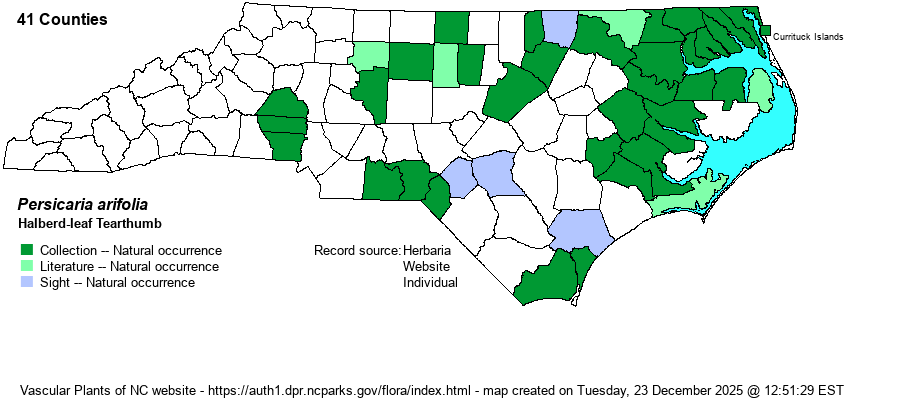| Author | (L.) Haraldson | |
| Distribution | Coastal Plain and lower Piedmont; scattered elsewhere in the Piedmont, rare in the Sandhills proper. Does not occur in the Mountains.
N.S. to MN, south to northeastern FL and western TN. | |
| Abundance | Fairly common to common in the northeastern Coastal Plain, south to Jones County. However, uncommon westward into the northeastern Piedmont; and very rare to rare in the rest of its NC range. | |
| Habitat | Wet, rather nutrient-rich, soils of freshwater marshes, brackish and fresh-tidal marshes, beaver ponds, margins of swamps and bottomlands, roadside ditches. | |
| Phenology | Flowering and fruiting July-November. | |
| Identification | Halberd-leaf Tearthumb is unique in its broadly triangular leaves with two basal lobes, the lobes and the leaf tip rather sharply pointed. The 3-6-foot long stems sprawl over other vegetation or the ground, are rather square in cross-section, and beset with an abundance of recurved prickles. Arrowleaf Tearthumb (P. sagittata) is similarly prickly and sprawling, but its leaves are half as wide and the basal lobes point backward. Both species have small balls of pink to whitish flowers at the tips of long stalks, raised above the leaves. Each of these two species is to be avoided when walking through a marsh! The stiff hairs can easily tear your flesh and thin clothing. | |
| Taxonomic Comments | Named in many references as Polygonum arifolium.
Many species formerly treated in the genus Polygonum have been moved to Persicaria, the smartweeds. These are generally erect and tall plants with terminal and axillary floral spikes; most occur in wetlands. Others remain in Polygonum, the knotweeds, which are generally prostrate to ascending and with inconspicuous axillary flowers. They occur mostly in dry soils and tend to be weedy.
Attention must be paid to the small collars at the junction of the main stem and leaf stems (called ocreae) and whether they possess terminal hairs or bristles. Some keys also refer to the even smaller collars from which flowers emerge (called ocreolae). Another important ID character is the surface of the greenish sepals -- whether smooth or dotted with indentations (punctate). | |
| Other Common Name(s) | Halberd-leaf Smartweed | |
| State Rank | S4 | |
| Global Rank | G5 | |
| State Status | | |
| US Status | | |
| USACE-agcp | OBL link |
| USACE-emp | OBL link |

